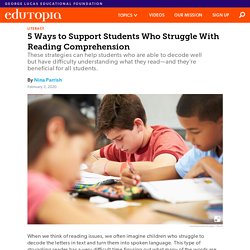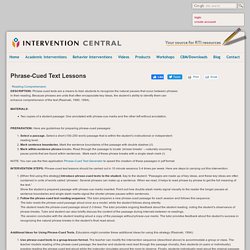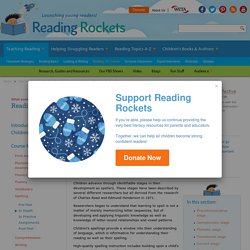

Thematic Units. Week 7 Dollins Student - Google Slides. Week 6 Dollins Student - Google Slides. Week 4 Dollins Student Wednesday - Google Slides. Week 3 Dollins Student - Google Slides. Dollins Week 2 Student in Class - Google Slides. Dollins Week 1 Literacy Student - Google Slides. Decodable Reader Protocol 2018. Developing Collaborative Conversations Through Literature Circles. Cult of Pedagogy. Teaching Text Structures for Non-Fiction Reading. - Help for Children With Dyslexia. 5 Ways to Support Students Who Struggle With Reading Comprehension.
When we think of reading issues, we often imagine children who struggle to decode the letters in text and turn them into spoken language.

This type of struggling reader has a very difficult time figuring out what many of the words are and has poor phonological (speech-sound) skills. However, there are also many students who sound like they’re reading beautifully but have difficulty with understanding vocabulary and figurative language, inferencing, verbal reasoning, grammatical development, and oral expression. As children get older, if they are decoding text well we assume they are reading well. Once a person learns to decode, reading comprehension becomes more about language comprehension and focus. At this transition, starting around third grade, teachers may begin to notice some students who decode text fluently but are not understanding.
These struggling readers should be targeted for remediation—the earlier the better. Supporting Students Who Struggle With Comprehension 1. 2. 3. 4. Academic Language for Student Success. 5-Minute Latin and Greek Roots. Where did English come from? - Claire Bowern. Phrase-Cued Text Lessons. DESCRIPTION: Phrase-cued texts are a means to train students to recognize the natural pauses that occur between phrases in their reading.

Because phrases are units that often encapsulate key ideas, the student’s ability to identify them can enhance comprehension of the text (Rasinski, 1990, 1994). Two copies of a student passage: One annotated with phrase-cue marks and the other left without annotation. PREPARATION: Here are guidelines for preparing phrase-cued passages: Select a passage. Select a short (100-250 word) passage that is within the student’s instructional or independent reading level.Mark sentence boundaries.
NOTE: You can use the free application Phrase-Cued Text Generator to speed the creation of these passages in pdf format. INTERVENTION STEPS: Phrase-cued text lessons should be carried out in 10 minute sessions 3-4 times per week. [When first using this strategy] Introduce phrase-cued texts to the student. Additional Ideas for Using Phrase-Cued Texts. References. Station Rotation: Differentiating Instruction to Reach All Students. Areas of Literacy Instruction (ALI) - Fluency.
Developmental Spelling Stages. Spelling: In Depth. Learn about the different stages young children go through in developing their spelling skills and how phonetic or "invented" spelling can play an important role in helping children learn how to write.

Children advance through identifiable stages in their development as spellers. These stages have been described by several different researchers but all derived from the research of Charles Read and Edmund Henderson in 1971. Researchers began to understand that learning to spell is not a matter of merely memorizing letter sequences, but of developing and applying linguistic knowledge as well as knowledge of letter-sound relationships and vowel patterns. Children’s spellings provide a window into their understanding of language, which is informative for understanding their reading as well as their spelling. Excellent spelling instruction includes building upon a child's word knowledge and enabling them to move from one stage to the next. Learn the stages of spelling development below. Rica Pillars video. How to Administer an Informal Reading Inventory. Runningrecords. What Differentiated Instruction Is—and Isn't.
Modeled Guided Reading. The Reading Process: 3 Cueing Systems. Quick Tip - Anticipation/Reaction Guide. Differentiated Instruction for English Language Learners. Each student comes to school, not only with unique academic needs, but also with unique background experiences, culture, language, personality, interests, and attitudes toward learning.

Effective teachers recognize that all of these factors affect how students learn in the classroom, and they adjust, or differentiate, their instruction to meet students' needs. Getting Started Tomlinson and Imbeau (2010) describe differentiation as creating a balance between academic content and students' individual needs. They suggest that this balance is achieved by modifying four specific elements related to curriculum: Content — the information and skills that students need to learnProcess — how students make sense of the content being taughtProduct — how students demonstrate what they have learnedAffect — the feelings and attitudes that affect students' learning.